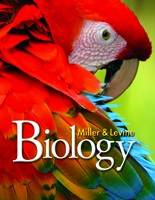 Education
Education
 Evolution
Evolution
What’s Wrong with the Miller & Levine Biology Textbook?
 After a contentious review process that attracted nationwide media attention, Kenneth Miller and Joseph Levine’s new edition of their textbook, Biology, has been adopted for use in Texas. Given the outsized influence that Texas has on textbook-selection across the country, this result will have a significant impact on science education elsewhere as well. In a series of posts here at Evolution News & Views, I have been analyzing and evaluating the scientific claims about evolution in the book, which is published by Pearson.
After a contentious review process that attracted nationwide media attention, Kenneth Miller and Joseph Levine’s new edition of their textbook, Biology, has been adopted for use in Texas. Given the outsized influence that Texas has on textbook-selection across the country, this result will have a significant impact on science education elsewhere as well. In a series of posts here at Evolution News & Views, I have been analyzing and evaluating the scientific claims about evolution in the book, which is published by Pearson.
Analyzing and evaluating is exactly what Texas’s science standards supposedly require students to do — to “analyze and evaluate” core evolutionary claims, including “common ancestry,” “natural selection,” “mutation,” “sudden appearance” of animal forms, the origin of the “complexity of the cell,” and the formation of “long complex molecules having information such as the DNA molecule for self-replicating life.” Despite this requirement by the state’s own educational standards, the Texas Essential Knowledge and Skills (TEKS), Miller and Levine’s textbook consistently overstates the case for Darwinian evolution as an explanation for the origins of complex life, while failing to discuss evidence that challenges the standard Darwinian narrative.
I invite readers, including parents, teachers and students, to consider the results of my review of the textbook. As we have seen, its major errors and omissions include:
- Promoting the blatantly false claim that “every scientific test to-date has supported Darwin’s basic ideas”;
- Wrongly claiming that DNA evidence unambiguously supports the common ancestry of all living organisms;
- Ignoring the growing body of scientific evidence that shows there is not enough time in the fossil record to generate many complex features we see in life, and omitting mention of the views of many credible scientists who have noted the failure of Darwinian evolution to explain the origin of novel features in biology;
- Wrongly suggesting we know that life’s “building blocks,” including replicating RNA, can appear through natural processes;
- Downplaying the frequency of abrupt appearance in the fossil record, and understating the scope of the dramatic abrupt burst of new diverse organisms that appeared in the Cambrian explosion;
- Omitting important facts about the Galápagos finches which show they demonstrate only limited oscillating evolution, not evidence that natural selection can produce new species.
It isn’t too surprising to learn that Miller’s textbook misinforms students about scientific controversies over evolution. After all, when Texas adopted its strong science standards in 2009, he announced his intent to write a textbook that wouldn’t follow the law. Dr. Miller is welcome to write whatever kind of textbook he likes. But students who use his work will be systematically misinformed about the scientific evidence.
The Miller & Levine textbook withholds from students much of the scientific evidence that challenges conventional theories of biological and chemical evolution. The good news is that it’s a free country, so schools that want to teach evolution objectively aren’t obligated to use this book.
